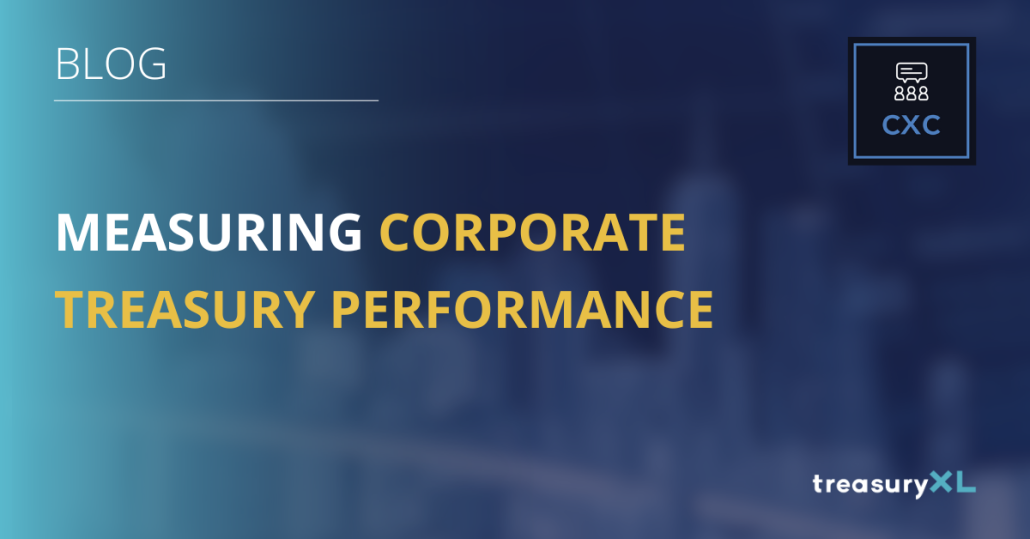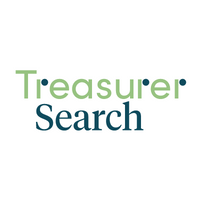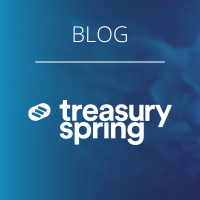Measuring Corporate Treasury Performance
By ComplexCountries
“Our new CFO …. has asked me, ‘How do I know you guys are doing a good job?’…. For a CFO whose life is measured by KPIs (growth, profitability, etc.), not having a KPI for Treasury, I understand, is a bit of an issue.”
“Treasury is like blood in the system. Nobody cares about how the blood is flowing unless they are bleeding.”
These quotes from the call sum up the challenge all treasurers face. A lot of the value added can’t be measured by traditional KPIs, and the importance of Treasury is often not appreciated until something goes wrong.

Treasurers measure many aspects of their activities, but these are often not easily understood by the business, and do not equate to a better or worse performance. Even something as simple as bank fees needs to be assessed in context: going with the cheapest bank may be a very bad idea. There are many difficult calls – but there is no way of knowing what would have happened if a different option had been taken. Risk management is key: but success here means nothing goes wrong. That rarely makes the headlines, or earns plaudits from management.
Most treasurers agree it is the best job in finance. There is a key operational component, some serious technical issues to grapple with, and a need to exercise judgment in many areas where there is no clear right or wrong answer. But, according to the participants on this call, what matters most is managing the key relationships – with bankers, markets, and the internal silos.
So – how do treasurers manage?
- Most use measurements as management tools, not to impress management or other functions. Cash cover for dividends, percentage of credit lines utilised, support from banks compared to wallet share – these are not absolute indicators of good or bad performance, but they improve decision making. These internal indicators are often shared with management or other functions. This provides an opportunity to make them aware of decisions, challenges and business changes.
- In turn, this helps with the theme which recurs most: becoming a trusted advisor to the business. One participant achieves this by ensuring quarterly reviews by the team with key business leaders, both inside finance and in other functions. This gives the team visibility: it also turns the discussion away from “what did you do for me today” to how to address business issues and problems. One example was currency hedging: this approach has turned the discussion from how much the hedges gained or lost, to how effective they have been in reducing volatility.
- At the same time, this sharing put the spotlight on the treasury teams. Their – excellent – work is often done away from the main focus of the business, and so is not appreciated. Correcting this is good for the team – but it also means Treasury’s role is better appreciated in times of stress.
- Related to this, there is consensus that the pandemic helped give businesses a better appreciation of the value Treasury adds.
- Treasurers do run a vital and complex back office function. While this is not where most value is added to the business, it is essential to keep operations under control – fraud or significant losses end careers. Here, the traditional KPIs do work and are effective – most measure items such as the percentage of STP, the number of late payments, etc. Productivity tools, such as TMSs and automation are big aids. Additionally, the KPI data can help educate other functions on just how much processing is actually happening in Treasury.
- There was a lot of discussion about measuring banking transactions. While this can never be an exact science – you need to make assumptions about spreads etc – it provides a good indicator of who is adding value. Nearly every treasurer who has implemented a bank fee tracking tool has found items being charged outside the agreements.
- One participant has a policy of continual improvement: each team has a project to improve something each quarter. These, and the accompanying measurements, are shared with the CFO and the business each quarter. It is an effective way of showing how Treasury is adding value, and putting a spotlight on issues the business would not necessarily focus on.
- No-one on the call was particularly troubled by the occupational hazards of ever decreasing budgets or HR requiring KPIs for the internal performance management system. While these have to be managed, they are a fact of life – but good communications with other functions result in an appreciation of the real value treasury brings.
Bottom line: except for the back office, it is very difficult to provide an objective measurement of Treasury’s performance. But, by engaging the business and sharing discussions on the issues Treasury is grappling with – issues for which there is often no objective measurement of “better” or “worse” – treasurers achieve the real objective, which is to provide thought leadership and add value through being a trusted advisor.
It is all about relationships: building these in good times pays dividends when the going is less smooth.
To Access this Report:
Access to the full report is available to Premium Subscribers of ComplexCountries. Please log in on the website of ComplexCountries to access the download.
Please contact ComplexCountries to find out about their subscription packages.
Can’t get enough? Check out these latest items
 https://treasuryxl.com/wp-content/uploads/2025/09/Nomentia-BLOGS-featured-5.png
200
200
treasuryXL
https://treasuryxl.com/wp-content/uploads/2018/07/treasuryXL-logo-300x56.png
treasuryXL2025-12-12 12:54:092025-12-12 13:07:57Nomentia Announces Leadership Transition to Drive Next Phase of Growth
https://treasuryxl.com/wp-content/uploads/2025/09/Nomentia-BLOGS-featured-5.png
200
200
treasuryXL
https://treasuryxl.com/wp-content/uploads/2018/07/treasuryXL-logo-300x56.png
treasuryXL2025-12-12 12:54:092025-12-12 13:07:57Nomentia Announces Leadership Transition to Drive Next Phase of Growth https://treasuryxl.com/wp-content/uploads/2023/03/Treasurer-Search-Logo.png
200
200
treasuryXL
https://treasuryxl.com/wp-content/uploads/2018/07/treasuryXL-logo-300x56.png
treasuryXL2025-12-11 14:07:112025-12-11 14:09:21Sales Director Investments @ Treasurer Search
https://treasuryxl.com/wp-content/uploads/2023/03/Treasurer-Search-Logo.png
200
200
treasuryXL
https://treasuryxl.com/wp-content/uploads/2018/07/treasuryXL-logo-300x56.png
treasuryXL2025-12-11 14:07:112025-12-11 14:09:21Sales Director Investments @ Treasurer Search https://treasuryxl.com/wp-content/uploads/2025/12/HSBC.png
200
200
treasuryXL
https://treasuryxl.com/wp-content/uploads/2018/07/treasuryXL-logo-300x56.png
treasuryXL2025-12-11 14:02:562025-12-11 14:02:56Middle Office Assistant – Trade Finance @ HSBC
https://treasuryxl.com/wp-content/uploads/2025/12/HSBC.png
200
200
treasuryXL
https://treasuryxl.com/wp-content/uploads/2018/07/treasuryXL-logo-300x56.png
treasuryXL2025-12-11 14:02:562025-12-11 14:02:56Middle Office Assistant – Trade Finance @ HSBC https://treasuryxl.com/wp-content/uploads/2024/01/Template_VACANCY-featured.png
200
200
treasuryXL
https://treasuryxl.com/wp-content/uploads/2018/07/treasuryXL-logo-300x56.png
treasuryXL2025-12-11 13:48:452025-12-11 17:05:04Vacature Sales Director Investments – Klantengroep Large Corporates
https://treasuryxl.com/wp-content/uploads/2024/01/Template_VACANCY-featured.png
200
200
treasuryXL
https://treasuryxl.com/wp-content/uploads/2018/07/treasuryXL-logo-300x56.png
treasuryXL2025-12-11 13:48:452025-12-11 17:05:04Vacature Sales Director Investments – Klantengroep Large Corporates https://treasuryxl.com/wp-content/uploads/2025/11/FinanceKey-Featured.png
200
200
treasuryXL
https://treasuryxl.com/wp-content/uploads/2018/07/treasuryXL-logo-300x56.png
treasuryXL2025-12-11 07:00:242025-12-11 09:16:42How to Design a Treasury Technology Roadmap
https://treasuryxl.com/wp-content/uploads/2025/11/FinanceKey-Featured.png
200
200
treasuryXL
https://treasuryxl.com/wp-content/uploads/2018/07/treasuryXL-logo-300x56.png
treasuryXL2025-12-11 07:00:242025-12-11 09:16:42How to Design a Treasury Technology Roadmap https://treasuryxl.com/wp-content/uploads/2025/08/Blog-Kyriba-7.png
200
200
treasuryXL
https://treasuryxl.com/wp-content/uploads/2018/07/treasuryXL-logo-300x56.png
treasuryXL2025-12-10 07:00:092025-12-09 16:38:22Does your company need a Head of Working Capital (and why nobody seems to have one)?
https://treasuryxl.com/wp-content/uploads/2025/08/Blog-Kyriba-7.png
200
200
treasuryXL
https://treasuryxl.com/wp-content/uploads/2018/07/treasuryXL-logo-300x56.png
treasuryXL2025-12-10 07:00:092025-12-09 16:38:22Does your company need a Head of Working Capital (and why nobody seems to have one)? https://treasuryxl.com/wp-content/uploads/2024/08/Surecomp-BLOGS-featured-3.png
200
200
treasuryXL
https://treasuryxl.com/wp-content/uploads/2018/07/treasuryXL-logo-300x56.png
treasuryXL2025-12-09 07:00:012025-12-08 16:15:18Trade Finance in the Nordics: What Scandinavian corporates really want in 2026
https://treasuryxl.com/wp-content/uploads/2024/08/Surecomp-BLOGS-featured-3.png
200
200
treasuryXL
https://treasuryxl.com/wp-content/uploads/2018/07/treasuryXL-logo-300x56.png
treasuryXL2025-12-09 07:00:012025-12-08 16:15:18Trade Finance in the Nordics: What Scandinavian corporates really want in 2026 https://treasuryxl.com/wp-content/uploads/2025/12/TreasurySpring-van-Template-4.png
200
200
treasuryXL
https://treasuryxl.com/wp-content/uploads/2018/07/treasuryXL-logo-300x56.png
treasuryXL2025-12-08 08:39:122025-12-08 08:39:12Odds of cuts being cut!
https://treasuryxl.com/wp-content/uploads/2025/12/TreasurySpring-van-Template-4.png
200
200
treasuryXL
https://treasuryxl.com/wp-content/uploads/2018/07/treasuryXL-logo-300x56.png
treasuryXL2025-12-08 08:39:122025-12-08 08:39:12Odds of cuts being cut! https://treasuryxl.com/wp-content/uploads/2023/03/Treasurer-Search-Logo.png
200
200
treasuryXL
https://treasuryxl.com/wp-content/uploads/2018/07/treasuryXL-logo-300x56.png
treasuryXL2025-12-05 10:45:072025-12-05 10:45:07Senior Manager Treasury – Utrecht Region @ Treasurer Search
https://treasuryxl.com/wp-content/uploads/2023/03/Treasurer-Search-Logo.png
200
200
treasuryXL
https://treasuryxl.com/wp-content/uploads/2018/07/treasuryXL-logo-300x56.png
treasuryXL2025-12-05 10:45:072025-12-05 10:45:07Senior Manager Treasury – Utrecht Region @ Treasurer Search


